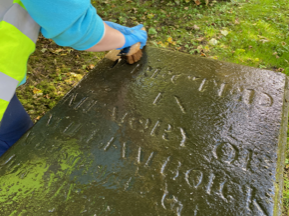
Many members of the SCMA are active in ensuring that their local gravestones and monuments are kept in a clean and presentable condition. Some families have been doing this for years, passng on the mantel to the next generation.
The guide to the right gives an indication of what to do if you are cleaning a memorial. Please note, in many cases it is worth checking out that you can carry out this work, either from the council (in the case of an old churchyard) or the landowner, if the memorial is in a field or on the hillsdie. In most cases, they will be happy that you wish to help preserve the stone.
Video
The attached video shows the members of the Crawford, Scott and McLean family cleaning the stone to WIlliam Boick at the Clachan of Campsie.
This was previously done by James Scott, and the family have continued doing it in their father's memory ever since.
Cleaning Stones and Monuments
1 Use the gentlest method possible first
This means using water and a soft brush .
2 Never use a wire or abrasive bristle brush
Always use the softest brush possible, and if this does not work, try a slightly harder brush. Take many different sized brushes so that you can get into small spaces. Make sure that any metal or hard surfaces on a brush are covered.
3 Use water and a soft plastic scraper, rinsing all the time, and using clean water each time
A garden pump ican be used to keep a flow of water over the stone. It is essential to use plenty of clean water and to keep the brush wet at all times. I like using kitchen roll as it is very soft and soaks up lots of water. Remember to keep rinsing and pushing the water away after brushing and never leave the stone to dry without thoroughly rinsing.
4 Brush in gentle circular pattern
Always clean the whole surface of the stone once you have begun. It is best to start at the top of the stone and to work down so that any dirty water does not mark the part of the stone you have already cleaned.
5 Do not be tempted to scrub hard or expect a pristine stone!
6 Never use household cleaners
There are many cleaning products which can achieve a quick and effective clean, but at the expense of damage to the stone. Avoid any cleaners containing bleach or acid. These may destroy the composition of the stone, altering the surface which in turn can lead to faster weathering in future making the lettering less readable.
7 If still not clean enough try a mild biological cleaning solution called D2.
It is recommended that you don't use anything stronger than water. However if you are determined to do so, try D2, which is quite safe and it kills the lichen beneath the surface of the stone so it will continue to improve in appearance after you have cleaned it. It is always a good idea to test a small area of stone and wait several days before tackling the whole stone. Remember to use plenty of water and to wet the stone down first.
8 You should not clean a headstone more than once a year
Even the gentlest clean will remove a small amount of the stone's surface.





